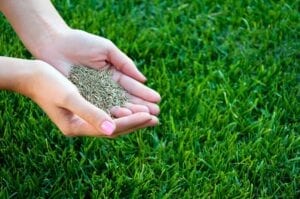Whew….we made it. We got thru those sweltering days of summer! But how did your lawn do? Being that it is the most visible part of your landscape, most of us want it to look green and lush all year long. No problem. We can do this!
1. The first thing to assess the condition of the lawn.
- If between 50 and 75 percent is in bad shape; weeds, fungus, insect damage whatever, you need to make a decision to totally kill the entire lawn and start over. I like to use a broadleaf weed killer in the latter days of August or early September so it has done its work and then has dissipated as not to interfere with the growth of the new seed.
- If 30% or less of the lawn is beat up then maybe patching is in order. Start off by getting rid of the existing weeds. If it is a small enough job I will have the weeds pulled out by hand (I try to enlist the aid of unsuspecting family members).
2. Once that is all done it’s time to get rid of any dead grass or debris that has accumulated. A good garden rake is a great tool for this task. Its short stiff teeth help rip out all that bad stuff that we don’t want in the way of the new seed or sod. Try to loosen the soil as much as you can to give the new seed a great home. (Note: If the soil is really compacted you may want to rent a core aerator. This machine punches holes in the soil that will allow all the things roots need to get down to them as well as allowing roots to extend in all directions.)
 3. Assessment time! Get a soil test. Let’s find out if we need lime or other soil amendments. This will get the renovation off to good start. Simply bring a ½ cup of completely dried soil to our Lawn & Garden Information Booth any time for a FREE pH test while you wait.
3. Assessment time! Get a soil test. Let’s find out if we need lime or other soil amendments. This will get the renovation off to good start. Simply bring a ½ cup of completely dried soil to our Lawn & Garden Information Booth any time for a FREE pH test while you wait.
4. O.k. now for the grass seed. Choose a good quality seed that is suited to your lawn, a sun mixture, a shade mix or a sun & shade mix for a little bit of both. Our experts are here to help you choose the correct seed and to provide tips for easy application. Spread the seed evenly by hand in small areas or use a spreader to do large areas. One pass in one direction and then one pass in the other direction will give you a good even distribution.
5. Now the fun part. Purchase premium lightweight topsoil. (Some even come with a starter fertilizer mixed in). Take this topsoil and like cheese on macaroni, give a nice coating layer on top of the seed, about 1/8” to 1/4” thick. This serves several functions: it keeps the seed moist and in contact with the earth. It also protects the seed from birds and wind blowing the seed around. Keep the area moist with gentle watering while the seed is germinating which might be a few weeks.
6. Fertilize the entire lawn now and again in late October with an organic lawn fertilizer.
7. And lastly, mow when the grass grows about 2” tall and there you go. Nice job!
By Felix Cutrone.
